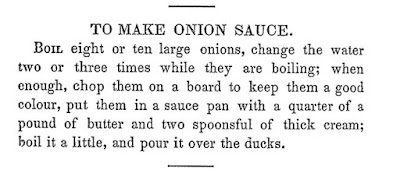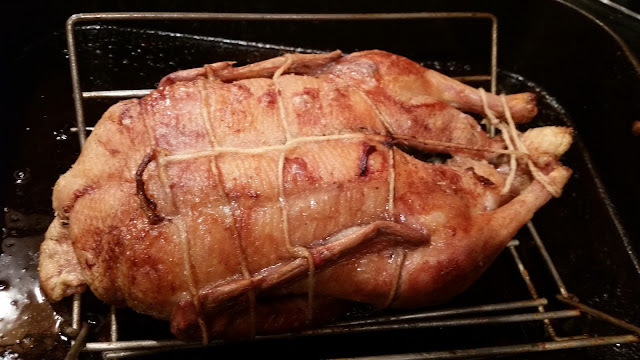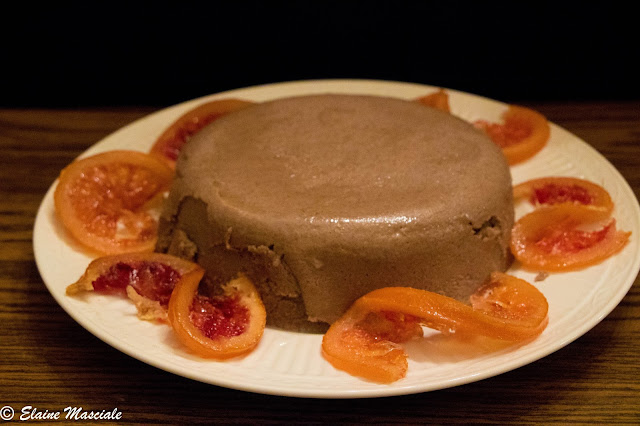Roast Duck with Onion Sauce
Roast Duck
Challenge #5: Roasts They’re a staple of the historic table, in many different shapes and forms and types. It’s also a cooking technique. Try a historic recipe for a roast, or a recipe that involves roasting, and tell us how it turned out.
Challenge #5: Roasts They’re a staple of the historic table, in many different shapes and forms and types. It’s also a cooking technique. Try a historic recipe for a roast, or a recipe that involves roasting, and tell us how it turned out.
This challenge was a bit more, um, challenging. I had already made a roast beef for the first challenge (meat and potatoes) and puzzled over what to make. I wanted to try something totally different and chose duck.
The Recipe, Year and Region
Today's recipe comes from The Virginia Housewife by Mrs. Mary Randolph, published in 1838 in Baltimore. Some people consider it to be the first truly American cookbook.
There are actually several recipes involved

We also need to make onion sauce as an accompaniment
 |
| From the Virginia Housewife, 1838 |
Ingredients:
1 whole duck, approximately 5.3 lb
giblets from said duck
water
flour (no more than 1/4 c)
salt, pepper
6 peppercorns (more or less)
1 large blade of mace
walnut catup (about 2 serving spoonsful)
1 T lemon juice (cheater version - more on this later)
onions (I used 6 small white, 2 large Spanish. They were what I had on hand) plus 1 more
4 leaves dried sage
1/4 lb butter
3 serving spoons of heavy cream
DUCK
Clean the duck by removing the neck and giblets, reserve these in a 2 qt sauce pan. Rinse the duck well and pat dry.
Preheat the oven to 425 degrees F.
Place a roasting rack in a roasting pan.
Chop a small onion, crumble some leaves of sage (I had dried sage from my summer garden)
Truss the legs, tail, and wings with butcher's string. Tuck the neck into the cavity.
Dust both sides of the duck with flour and pat into the skin Place on a roasting rack, breast side up.
Put into the oven and let roast 45 min.
Gently turn the duck over, breast side down. Roast 15 min.
Turn the duck breast side up. Continue roasting until the meat at the leg joint tests at 180 degrees
Remove the duck from the oven, let rest. Carve.
MEANWHILE....
GRAVY
Place the giblets and neck in a 2 qt saucepan. Add water (about 3/4 of the way up the pot).
Turn heat to medium low and let simmer while the duck cooks. Skim off the foam that arises at the beginning.
 |
| Time to skim the foam. This bit doesn't look very appetizing |
Then add 6 peppercorns and a blade of mace. Continue to simmer, watching the water level. Around the last turning of the duck, add 2 serving spoonsful of walnut catsup and lemon pickle (or lemon juice). Let gravy continue to simmer. Before serving remove all the meat and seasonings.
 |
| Gravy before removing giblets, neck, and spices |
ONION SAUCE
Peel the onions, add to a large saucepan (I used a 4 qt) and cover with water. Bring to a brisk boil.
Drain all the water. Repeat 2 more times. My assumption is that this technique is meant to render the onions more mild. A similar technique is used in making candied peel. After the third boiling, remove the onions to a cutting board and chop.
Return to the saucepan, add 1/4 lb butter and stir to melt.
Add heavy cream and bring to a boil. Salt to taste.
 |
| Onion sauce in bowl for serving |
COMMENTS ON COOKING
Duck I chose my oven temperature from reading several modern recipes for duck. Of course The Virginia Housewife doesn't give a temperature for duck, so I took that from a contemporary cookbook.
Gravy - I initially added freshly ground pepper to the giblets and water, only to see it all skimmed away with the foam. Peppercorns were a better choice If you have cooked giblets for turkey gravy in the past, this is very similar. There was no indication to thicken the gravy, so I left it clear and thin.
Blades of mace: Mace is the outer shell of the nutmeg. We normally find it as a ground spice in the grocery stores. I hunted down blade mace in an Indian grocery store. Without an actual blade of mace, I had no idea what quantity of ground to substitute.
Walnut catsup: I had already made black walnut catsup several years ago (the stuff just doesn't spoil). No particular catsup is specified, but tomato catsup was not very popular at the time of the recipe. My top guesses were mushroom catsup or walnut catsup. I had run out of the mushroom catsup I made last summer, so walnut it was. If you don't have walnut catsup, Worcestershire sauce has a similar taste profile.
Here is the link to my posting on walnut catsup
http://hoopskirts.blogspot.com/2013/11/black-walnut-catsup.html
Lemon pickle. Lemon pickle is also called lemon catsup in cookbooks. I had made some a number of years ago and wouldn't trust it for cooking at this time. It takes several days for the lemon pickle to be completed Knowing I didn't have time to make new lemon pickle, I substituted a spoonful of lemon juice, to bring the fruity acid into the gravy.
Onion Sauce
Chopping the hot cooked onions was difficult and somewhat dangerous. The onions are very slippery and the heat made them impossible to hold. I would consider cooking the onions and letting them totally cool before chopping. This would take a good deal more time.
Time to Complete:
About 1 1/2 hrs. I made the gravy and the onion sauce while the duck was roasting. If precooking and cooling the onion, you would need to add more time.
Total Cost:
duck: $23 (at least it serves 4)
onions: $ 2 (I had these in my pantry)
sage: from my garden
butter, cream - already in my fridge. Butter is around $3 per pound, so about $0.75
How Successful Was It?:
I was worried at first we carved the duck, Modern cooking shows on television indicate the duck breast should be rare, and mine barely showed any pink. I enjoy eating duck but had never made it before. This was really going to be going out on a limb - and it wasn't cheap. |
| Duck with gravy, onion sauce |
And the results - DELICIOUS! Utterly, absolutely delicious. Serving it as specified in the recipe, I put the sliced duck breast on the plate, poured the giblet gravy over it, then added the onion sauce.
I learned something very important about historic cooking - all the tastes went together and were meant to be eaten together in one bite.. The duck without the gravy would not have been as moist, and the onion sauce added a whole different layer of flavor. They all blended together into something more than the individual items.
A serving suggestion: if I were to make this again (and I have half a roast duck left with oplenty of gravy and onion sauce) I would add sides of cranberry sauce or pickled onion. The bright tart fruit would be a lovely accompaniment.
 |
| Eat the duck, the gravy, and the onion sauce together. DELIGHTFUL! |
How Accurate Is It?:
Overall, I think the duck was very accurate. I made a few small adjustments, mainly to deal with the fact that I don't have a hearth.
Since I was not putting the duck on a spit and rotissing it over an open fire, I already knew there would be a difference. I thought that turning the duck several times to allow the skin on each side to brown would be a helpful adjustment. Using a roasting rack also helped to keep the fowl out of the liquid in the bottom of the pan.
Of course I used a meat thermometer. I don't have the acquired knowledge of roasting ducks, the knowledge of touch, and I refused to ruin the duck. A meat thermometer is a very easy accommodation.
The gravy was missing lemon pickle. I'd really like to know how it would have changed the sauce. The lemon juice gave a little bit of the needed taste.









I like your comment about eating the flavors together. I had a similar realization with my recipe (it was roast lamb + gravy + baked beans). It looks really tasty too!
ReplyDeleteAlso, your duck is BEAUTIFULLY trussed. Congrats on that beauty.